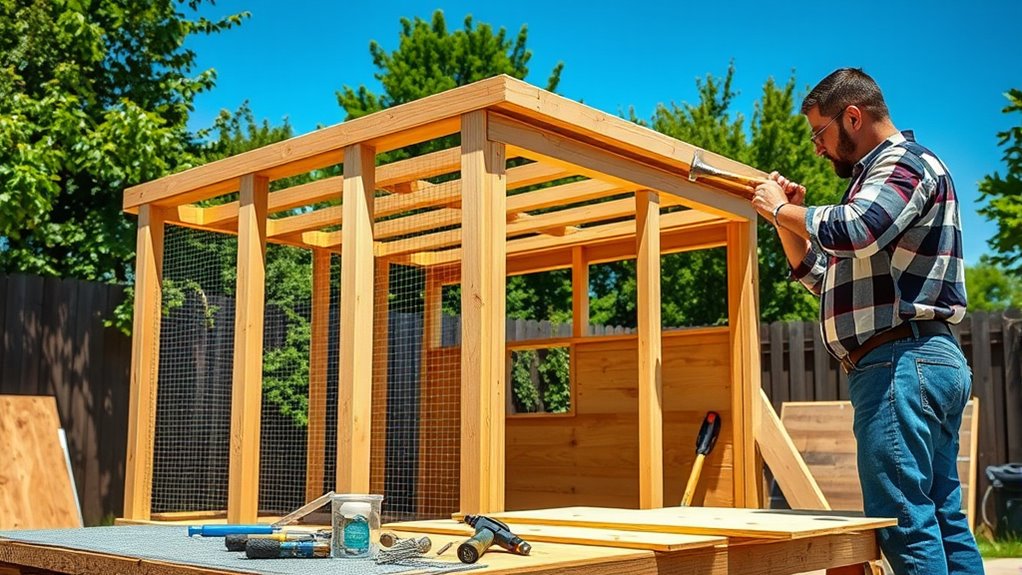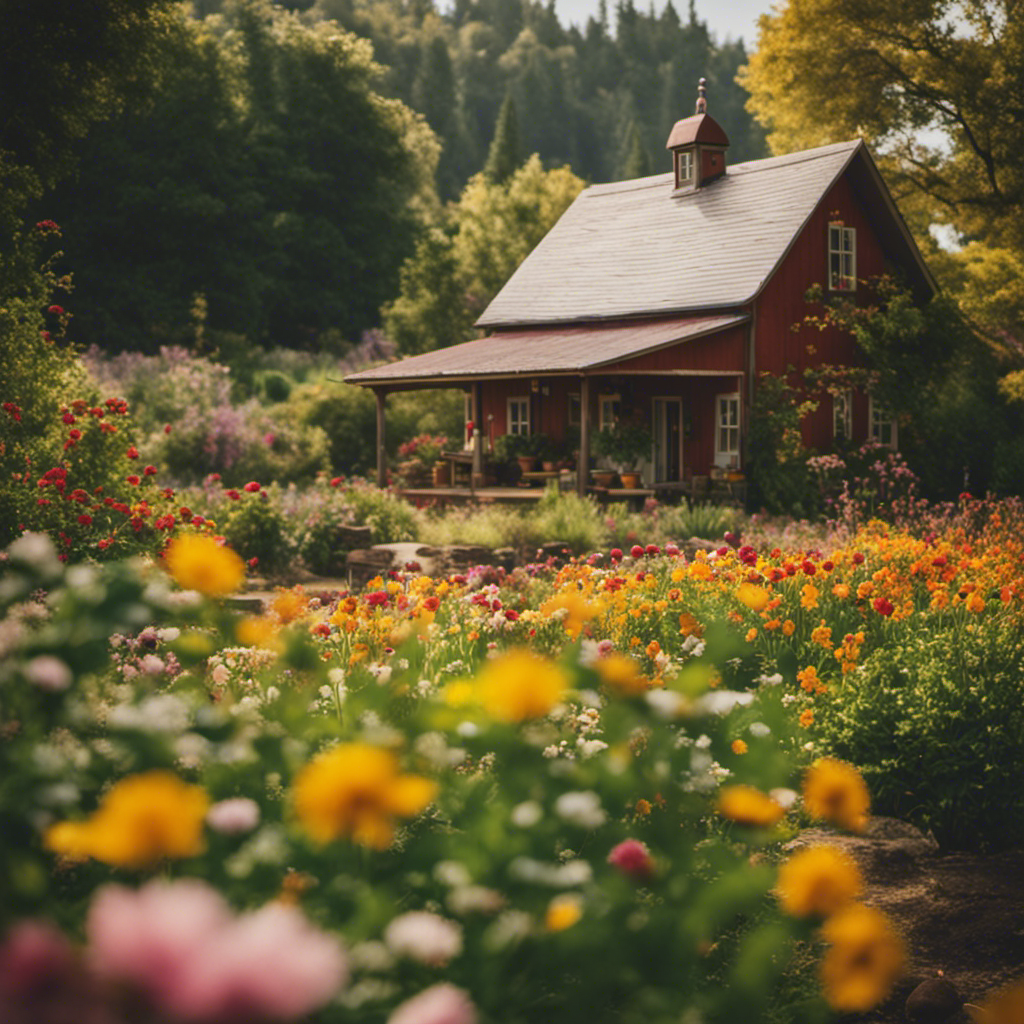Building a chicken coop is a practical project that requires careful planning to keep your flock safe and comfortable. From choosing the right location to selecting durable materials, every decision impacts the longevity and functionality of your coop. With proper design, it’s possible to create a space that’s both efficient and inviting. Interested in learning the key steps and tips that can help you build a reliable and well-designed home for your chickens?
Key Takeaways
- Select a site with good drainage, predator protection, and accessibility for maintenance and expansion.
- Use durable, weather-resistant materials for framing, roofing, and sealing to ensure longevity and weatherproofing.
- Design a safe, well-ventilated interior with comfortable perches, nesting boxes, and adequate space per bird.
- Incorporate predator deterrents like hardware cloth, secure latches, and motion-activated lights around vulnerable areas.
- Add personalized touches such as decorative elements, signage, or garden features to enhance aesthetics and functionality.
Assessing Your Space and Location

Before building your chicken coop, it’s essential to carefully assess your available space and location. Choose a spot with good drainage and enough room for future expansion. Consider installing solar lighting to guarantee your coop stays well-lit without added electricity costs, especially during shorter days. Proper lighting helps keep chickens comfortable and reduces stress. Additionally, evaluate predator risks in the area. Use predator deterrents like fencing, motion-activated lights, or buried wire to protect your flock. Position the coop away from dense brush or hiding spots for predators. Think about accessibility for daily chores and cleaning. A strategic location minimizes maintenance and keeps your chickens safe and secure, making your coop both functional and predator-resistant from the start. Incorporating predator protection strategies into your planning can significantly enhance your coop’s safety and longevity.
Selecting the Right Materials

Choosing the right materials is key to ensuring your coop stays comfortable and safe for your chickens. You need to contemplate options for proper ventilation and insulation that suit your climate. Additionally, selecting weather-resistant materials will help your coop withstand the elements and last for years.
Ventilation and Insulation Options
Selecting the right materials for ventilation and insulation is essential to maintaining a healthy and comfortable environment in your chicken coop. Natural ventilation helps keep fresh air circulating, reducing moisture and preventing respiratory issues.
You can achieve this by installing vents, windows, or adjustable louvers that allow airflow without drafts. When choosing insulation materials, opt for safe, non-toxic options like straw, foam boards, or mineral wool. These materials help regulate temperature and keep the coop warm in winter and cool in summer.
Proper insulation also prevents drafts and minimizes temperature fluctuations that stress your chickens. Make sure your materials are easy to clean and maintain, ensuring your coop remains hygienic and promotes the health of your flock.
Durability and Weather Resistance
Ensuring your chicken coop withstands harsh weather conditions starts with choosing durable, weather-resistant materials. Metal roofing is an excellent option because it’s strong, long-lasting, and sheds snow and rain efficiently. To prevent leaks, use weatherproof sealants around seams, joints, and openings. The right materials keep your chickens safe and comfortable year-round, and selecting appropriate installation techniques is essential for optimal durability.
Designing a Safe and Comfortable Interior
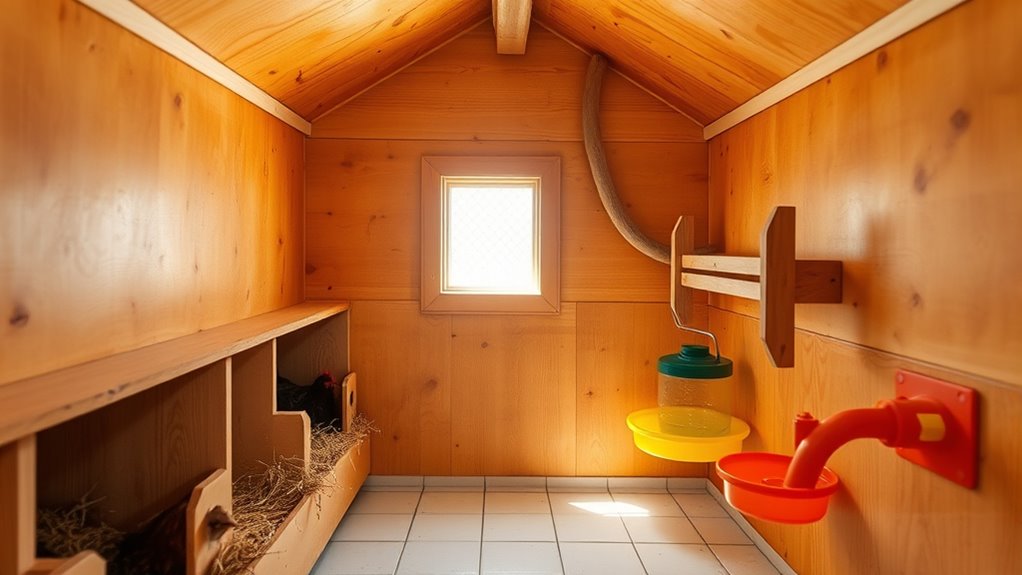
Creating a safe and cozy interior starts with ensuring proper ventilation so your chickens stay healthy and fresh. You’ll also want to include comfortable perching areas that encourage natural roosting behaviors. Incorporating vintage and antique furnishings can add character and authenticity to your coop, making it both functional and charming. Ultimately, designing easy access points makes cleaning simpler, keeping the coop hygienic and stress-free for your flock.
Adequate Ventilation
Proper ventilation is essential for maintaining a healthy and comfortable environment inside your chicken coop. Good air circulation prevents the buildup of harmful gases like ammonia and reduces moisture, which helps control humidity levels. Using ventilation design techniques effectively ensures optimal airflow throughout the coop. You should install adjustable vents or windows that can be opened and closed based on weather conditions. Make certain airflow moves across the coop without creating drafts directly on the chickens, as drafts can cause stress or illness. Proper ventilation also helps remove excess heat during hot months and keeps the air fresh year-round. Regularly checking and maintaining your ventilation system ensures it functions effectively.
Comfortable Perching Areas
A well-designed interior includes comfortable perching areas that keep your chickens safe and happy. Properly arranged roosting bars provide secure spots for your hens to rest. When installing roosts, consider perch heights—placing higher bars for dominant birds and lower ones for newcomers helps reduce pecking conflicts. Make sure the bars are smooth and sturdy to prevent injuries. Keep perches about 18-24 inches apart to give each chicken enough space. Use natural wood or rounded edges to ensure comfort. Adding multiple levels encourages activity and allows chickens to choose their preferred perch. Remember, a good perch setup minimizes stress and promotes healthy sleep, ultimately supporting your flock’s overall well-being. Incorporating comfortable sleep environments can further enhance rest and reduce stress among your chickens.
Easy Access for Cleaning
To keep your chicken coop clean and hygienic, designing it with easy access points is essential. Incorporate removable or hinged nesting boxes so you can quickly collect eggs and clean inside.
Make sure the coop’s doors and panels are wide enough to reach all areas without hassle. Use predator-proofing measures like secure latches and sturdy wiring to prevent predators from entering during cleaning.
Elevate the coop slightly off the ground to make cleaning underneath easier and reduce moisture buildup. Keep the interior simple and free of clutter, allowing you to sweep or scoop out droppings efficiently.
Regular access ensures you can maintain a fresh environment, promoting healthier chickens and reducing the risk of disease. Proper design makes maintenance straightforward and less time-consuming.
Additionally, incorporating Gold IRA Rollovers into your long-term financial planning can help secure your retirement funds, providing peace of mind for the future.
Planning for Proper Ventilation and Lighting
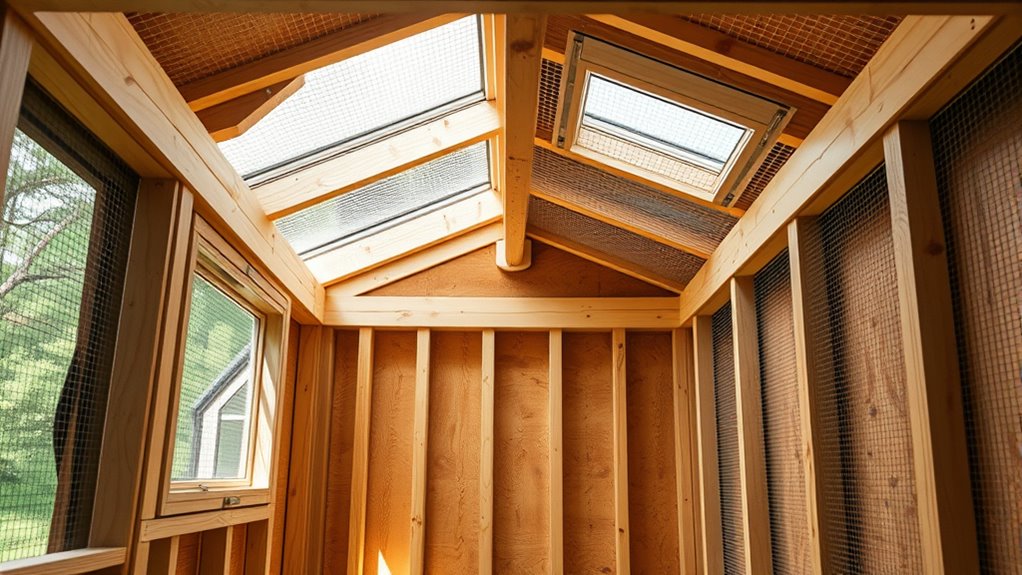
Ensuring good ventilation and adequate lighting is essential for a healthy and comfortable chicken coop. Proper airflow prevents moisture buildup and reduces respiratory issues.
When planning, consider these key aspects:
- Place vents high on the walls to promote natural airflow without causing drafts near roosting options.
- Position nesting boxes in a quiet, darker corner, away from direct sunlight, to encourage hens to lay eggs comfortably.
- Use windows or skylights to maximize natural light, which helps regulate chickens’ laying cycles and keeps them active.
- Incorporating automation in ventilation and lighting systems can help maintain optimal conditions consistently, enhancing overall coop health. automation in ventilation and lighting
Good lighting and ventilation also influence the placement of roosting options, ensuring chickens sleep comfortably and stay healthy.
Balancing these elements creates a safe, inviting environment for your flock.
Building a Sturdy Frame and Foundation
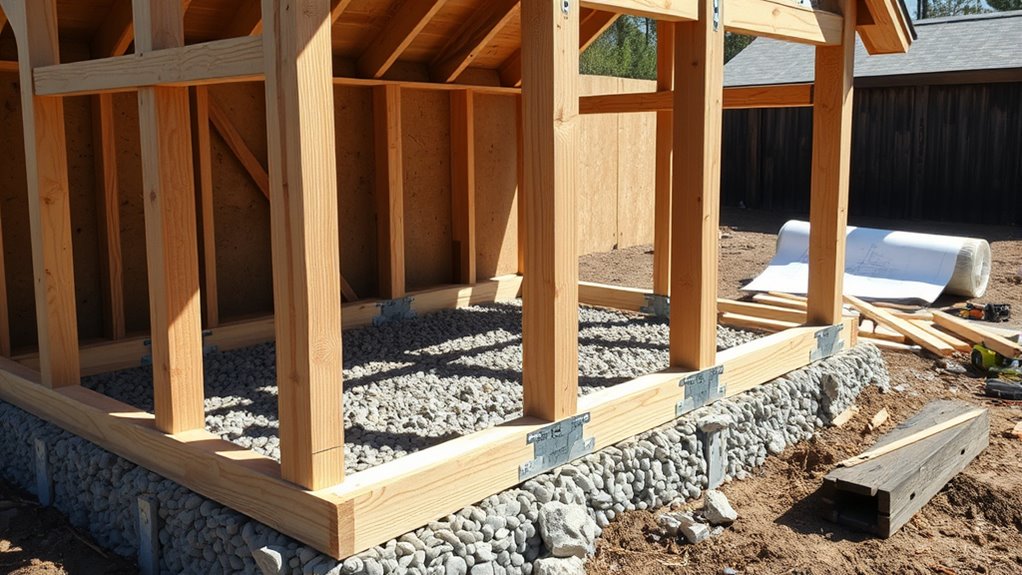
Before building the walls and roof, you need a strong foundation and frame that can support the entire coop. Start by leveling the ground and laying a sturdy concrete slab or using pressure-treated beams for the base.
A solid frame made from durable lumber ensures your coop withstands weather and predators. When constructing the frame, consider placement of nesting boxes, ensuring they’re accessible yet secure from predators.
Reinforce entry points and add predator prevention measures like hardware cloth around the base and vents. Accurate framing prevents wobbling and sagging, extending the coop’s lifespan.
A well-built foundation and frame offer stability, protect your chickens, and set the stage for a safe, functional coop that meets your needs.
Incorporating Easy Access for Cleaning and Maintenance
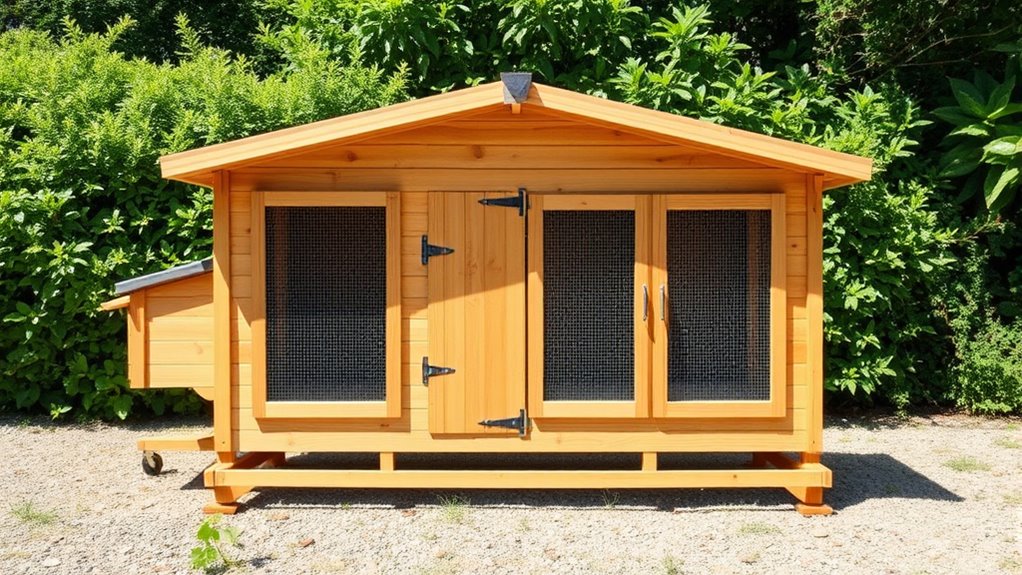
Incorporating easy access for cleaning and maintenance is essential for keeping your chicken coop healthy and manageable. You want to design it so you can quickly clear out waste, replace bedding, and inspect for issues. Consider these tips: 1. Install large, hinged doors or removable panels on the sides for easy cleaning access. 2. Place niches for niche plants that can be easily maintained without disturbing chickens, adding visual appeal. 3. Use decorative lighting inside and outside the coop, ensuring you can see clearly during cleaning and spot any problems early. 4. Design the coop with easy-to-clean surfaces that resist dirt buildup and make cleaning more efficient. These features make maintenance less of a chore and help keep your coop hygienic. Plus, accessible design encourages regular upkeep, which benefits your chickens’ health and your peace of mind.
Adding Predatory and Weatherproofing Features
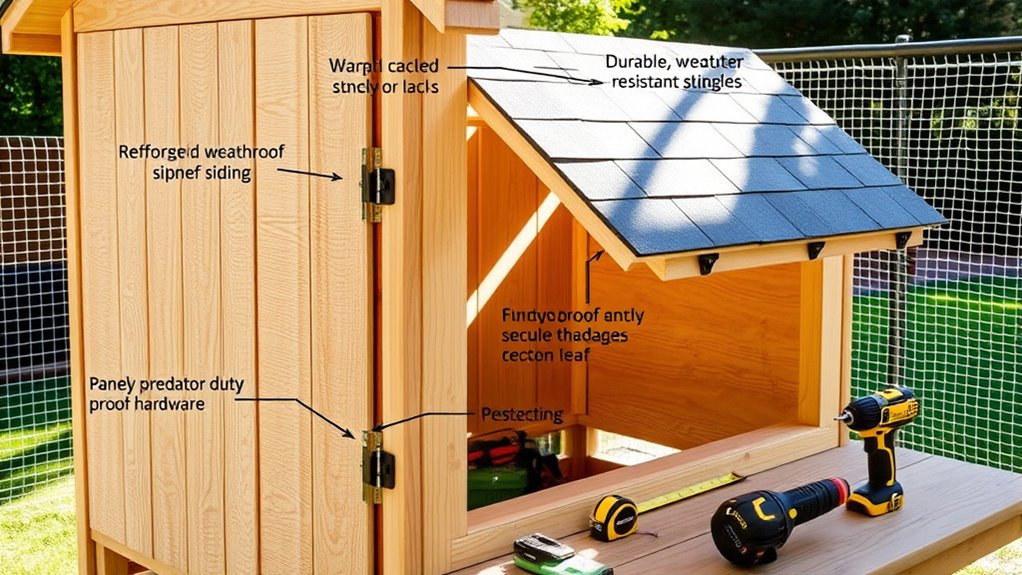
Protecting your chicken coop from predators and harsh weather is essential for your flock’s safety and well-being. To deter predators, install predator deterrents such as secure latches, hardware cloth, and motion-activated lights. Reinforce vulnerable entry points with sturdy materials, and ensure the coop is raised off the ground to prevent digging predators. Incorporating AI-powered security systems can further enhance protection by monitoring for threats remotely.
For weatherproofing, apply weatherproof sealing around doors, windows, and seams to keep moisture out and maintain a dry interior. Use durable roofing materials to withstand rain and snow. Proper weatherproof sealing not only protects the coop structure but also keeps your chickens comfortable and healthy.
Combining effective predator deterrents with weatherproof features creates a safe, durable environment that shields your flock from external threats.
Ensuring Adequate Space and Run Area

How much space do your chickens really need to thrive? Proper space optimization ensures healthy, happy hens.
A good rule of thumb is at least 4 square feet inside the coop per bird, plus 10 square feet in the run area.
Here are some tips to maximize space:
- Use vertical space—install roosts and nesting boxes up high to free up floor area.
- Keep the run area secure and spacious enough to prevent crowding and promote exercise.
- Incorporate movable fencing or panels to adjust the run size as needed.
- Choosing the right knitting patterns for your coop can also help create cozy, insulated spaces during colder months.
Focusing on both indoor space and run area helps prevent stress and disease, making your flock more productive.
Prioritizing adequate space is key to building a comfortable, healthy environment for your chickens.
Tips for Finishing Touches and Personalizing Your Coop
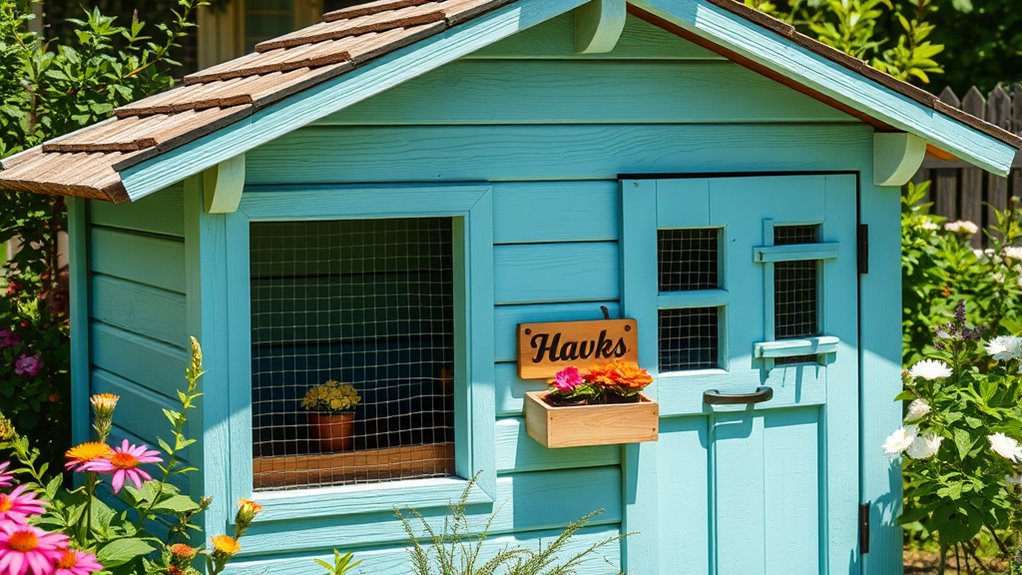
Adding personal touches to your chicken coop not only makes it more functional but also reflects your style and personality. Incorporate decorative touches like colorful paint, unique signs, or handcrafted elements to create a welcoming space.
You can also personalize the coop with practical features, such as custom nesting boxes or cozy perches that suit your chickens’ needs. Consider using natural materials like reclaimed wood for a rustic look or adding a small garden nearby to enhance the overall aesthetic.
These details allow you to express your personal style while making the coop more inviting. Remember, the key is to balance functionality with creativity, ensuring your coop is both practical for your flock and a reflection of your unique taste. Decorative elements can help make your coop stand out and feel more like a charming part of your backyard.
Frequently Asked Questions
How Do I Choose the Best Location for My Chicken Coop?
When choosing the best location for your chicken coop, you should prioritize good coop ventilation to keep your hens healthy and comfortable. Pick a spot that’s elevated to prevent flooding and away from predators, ensuring predator proofing.
Avoid direct sunlight during hot afternoons, and consider placing it near a natural windbreak. This setup helps maintain a safe, well-ventilated environment, promoting happy, healthy chickens.
What Are the Most Durable Materials for a Long-Lasting Coop?
You want a coop built with durable materials that last long and keep your chickens safe. Opt for weather-resistant options like treated wood or metal siding, which resist rot and pests.
Guarantee good coop ventilation to prevent moisture buildup and keep the environment healthy.
Incorporate a predator-proof design with sturdy locks and secure fencing to protect your flock, making your coop both durable and safe for years to come.
How Can I Ensure Proper Drainage Around the Coop?
To guarantee proper drainage around your coop, start with effective drainage solutions like installing a slight slope away from the structure. Proper soil preparation is key; loosen and grade the soil to prevent water pooling.
You can also add gravel or crushed stone beneath the coop foundation for extra drainage. Regularly inspect and maintain these areas, especially after heavy rains, to keep water from accumulating and harming your chickens.
What Are Common Mistakes to Avoid in Coop Design?
Did you know that poor coop design can lead to a 50% increase in health issues for your chickens? To avoid common mistakes, focus on proper coop ventilation to prevent moisture buildup and respiratory problems.
Also, prioritize predator proofing tips, such as secure latches and sturdy fencing. Avoid overcrowding and poor insulation, which can stress your flock.
These steps help guarantee a safe, healthy environment for your chickens to thrive.
How Do I Customize a Coop to Fit Different Chicken Breeds?
To customize a coop for different chicken breeds, you need to consider breed-specific accommodations like perch height, space requirements, and nesting box size.
You should also implement coop ventilation tips to ensure good airflow, preventing health issues.
Adjust the coop layout to suit the unique needs of each breed, providing enough space and comfort.
This approach helps keep your chickens happy, healthy, and productive, regardless of their breed.
Conclusion
Building a chicken coop is like crafting a cozy nest for your feathered friends. With careful planning, sturdy materials, and attention to safety, you can create a space that’s both functional and inviting. Keep their comfort in mind, add personal touches, and stay vigilant against predators. In the end, a well-built coop will be a happy home for your chickens, just like a warm nest is for a bird ready to soar.

